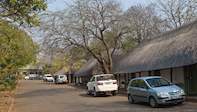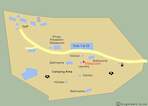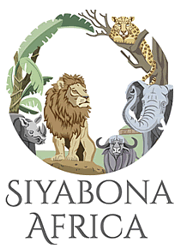
Punda Maria Camp lies in an area of fascinating history and unsurpassed bird watching. It also recognized as the best region inside the Park for Kruger National Park safari accommodation in which to spot the often shy Nyala Antelope.
Getting There

Where is Punda Maria Rest Camp?
Punda Maria Rest Camp is in the most northern section of Kruger National Park.
What is the closest Kruger Park entry gate to Punda Maria Rest Camp?
Punda Maria Gate is 8 km from Punda Maria Rest Camp.
What is the closest airport to Punda Maria Rest Camp?
Kruger Park Gateway Airport in Phalaborwa is the closest airport to Punda Maria Rest Camp (198 km).
How long does it take to drive to Punda Maria Rest Camp from Johannesburg?
By road, Punda Maria Rest Camp is 7 hours from Johannesburg (565 km).
What is the GPS coordinates of Punda Maria Rest Camp?
-22.692078, 31.016781
Facilities

What facilities does Punda Maria Rest Camp have?
- Information at Reception
- Swimming Pool
- Restaurant
- Cafeteria
- Shop
- Communal bathrooms
- Communal kitchens
- Laundromat
- Petrol station
- Cutlery and plates hampers (from Reception)
- Basic first aid assistance
- TVs (limited DSTV) available in family bungalows only
- Day Visitors Picnic Area (located 8 km outside of camp next to Punda Maria Gate)
- Cellphone reception
- Public Telephone
- Post Box
Accommodation

Where can I stay at Punda Maria Rest Camp?
Punda Maria Gate has a reception area and ablution blocks. Further down the hill are two terraces of pretty, whitewashed 2 bed and 3 bed bungalows. Each unit is air-conditioned and comes with a toilet, washbasin, built-in cupboards and a fridge. The three-bedded units have the added advantages of showers and fully equipped kitchens.
The bungalow tiers slope down towards a shared ablution, kitchen and barbecue facilities. There are 50 camp or caravan sites available.
Accommodation Types
- Bungalows
- Safari Tents
- Family Cottages
- Russell Guest Cottage
- Camp Sites
See more Punda Maria Rest Camp accommodation
Dining

Where can I eat at Punda Maria Rest Camp?
Each morning, the Punda Maria restaurant opens its doors early and remains open well into the evening, serving everything from hearty breakfasts and quick lunches to hearty dinners featuring South African favourites like spare ribs, chicken schnitzel, and steak all enjoyed in the restaurant or outside on the deck.
For those preferring to cook for themselves, many accommodation types have kitchens or guests can use communal kitchens (in proximity to the bungalows and safari tents) providing fully stocked cooking and braai facilities, ideal for a casual self-catered meal or a South African braai under starlit skies.
Wildlife

What wildlife can I see around Punda Maria Rest Camp?
Visitors to Punda Maria Rest Camp do not so much come for the game as for the camp's rich historical heritage since the vegetation supports fewer big game species than elsewhere in the Kruger Park.
Nevertheless, large herds of Elephant and Buffalo roam the Mopane-covered plains, Rare Tsebbebe and Sable are frequently sighted from this Kruger National Park rest camp.
Other wildlife that can be seen around Punda Maria include Impala, Zebra, Eland, Vervet Monkey, Baboon, Hippo, Nile Crocodile, Wild Dog and Lion.
Activities

What activities can I do at Punda Maria Rest Camp?
At Punda Maria Rest Camp, guests can explore the quieter, birding haven wilderness of northern Kruger National Park, perfect for spotting rarities like the crested guineafowl or Pel’s fishing owl. The bird hide overlooks the waterhole on the camping site fence.
Scenic drives along the Mahonie Loop reveal rugged baobab-dotted landscapes and frequent elephant sightings. For a deeper experience, guided night drives bring out elusive nocturnal animals, while the camp’s walking trail offers a peaceful self-guided stroll through mopane woodland.
The Punda Maria Rest Camp hide is a favourite spot to quietly watch wildlife gather at the waterhole as the sun sets.
See more Punda Maria Rest Camp activities
History of Punda Maria Rest Camp

The name of the rest camp was given in 1919 by the first ranger to be posted to the area, Captain JJ Coetser. He mistakenly named his post Punda Maria in the belief that this was the Swahili name for Zebra, the first big game he saw on arrival. The correct Swahili name is actually 'punda milia' (meaning Striped Donkey).
When the error was pointed out to him, he chose to retain the name, in honour of his wife, Maria, who bore him 12 children. Many years later, Park officials corrected the name, and for a while, the rest camp was known as Punda Milia, but in 1981 it was changed back to the original 'Punda Maria'.
When Captain Coetser was posted to Punda Maria Camp, his main aim was to curb ivory poaching. In the early 1900s, this region was the haunt of smugglers, poachers and hunters who based themselves in an assortment of derelict shacks at Crooks Corner, where the borders of South Africa, Mozambique (formerly Portuguese East Africa) and Zimbabwe (formerly Rhodesia) met at the confluence of the Limpopo and the Luvuvhu rivers.
Fugitives from the law could just slip across one of the borders and take refuge in foreign territory when the authorities came searching for them. The hunters at Crooks Corner realized that they could supplement their income from ivory by recruiting labour for the Witwatersrand mines, and illegal trade in labour began.
The government eventually put a stop to this and Wenela was given sole authority to recruit labour. The Wenela recruiting station now stands as a somber reminder on the S63 loop near Pafuri.


